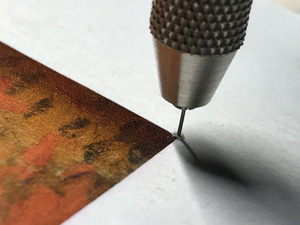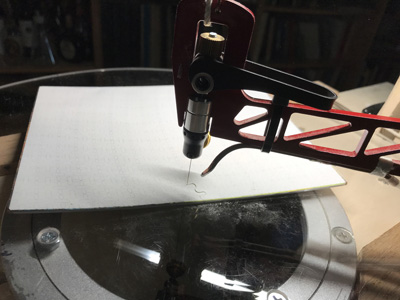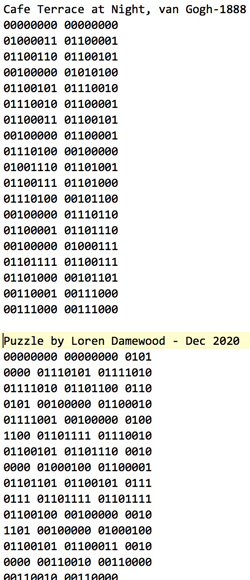(Congratulations are in order, to Tricia, who successfully decoded the message in the Gustav Klimt "Adele" puzzle. I've decided to include at least one more prize puzzle. Let her example be an inspiration to you!)
Background information:
A few years ago I had to come up with a good present for one of my nieces, and decided that a custom jigsaw puzzle would fill the bill. I had no idea what a pain in the butt it would be to develop the techniques needed to make a successful go of it, which is probably why I embarked on the project with such enthusiasm...
My first choice for a picture was from an artist whose work pleased me, and was familiar to the recipient, and I made a point of getting permission to use it. (Intellectual property is a sore point, seriously.) I must have spent weeks, trying and failing to get the picture applied to the thin plywood backing, and then using my jeweler's saw to cut pieces out. I didn't keep count, but I'd estimate that at least eight or nine of 'em ended up in the trash, with anywhere from one to a few dozen pieces cut before I found out how badly it was working.
We can skim lightly over all of the various dead ends, and go right to what seems to work: I use waterslide decal paper, with the image printed mirror-reversed. After sanding and priming 1/16" plywood, and before the primer is dry, I press the paper onto the board and roll out all the excess primer with an ink-roller, then I pile sandbags onto the whole thing and bake it in a warm oven, or wait several days... no, I'm kidding, I can't wait several days, warm oven it is.
If you're not familiar with decals, look them up. The next step, for my process, is to dampen the paper backing so that it will peel off, then inspect the image for bubbles or peeling. Failures go back for erasure (hand-sander with 80-grit paper) and I start over, but if it looks okay, I spray it with a clear sealer and bake it some more.
At this point I have the picture with correct orientation, smoothly adhering to a thin piece of 3-ply aircraft-model plywood. (Spruce? I think so. Whatever.) I trim the picture out of the sheet the same way I cut the individual puzzle pieces, with a jeweler's saw. I used to just cut the unused part away, then I decided to keep it as a mat, when framing the finished work. I could do it in sections, but I like to keep it all one piece, if possible, so I drill a tiny hole next to the picture, thread a saw blade through it, and carefully cut the picture out all in one piece, leaving a puzzle sized hole.
Here are a couple of pictures of that. First, the #80 drill:
 and then the hole... and then the hole...
Then I apply a cover sheet of paper with the puzzle pattern printed on it, and start to cut:

|
On to the puzzle contest:
I've made quite a few puzzles, and recently decided to play around with the patterns some more. Please observe the two sample images below:
 
|
There is a message in the pattern. In order to decode it, you have to render the lines between the rows as zeros and ones, i.e., binary, and group them into bytes, then look up the ASCII equivalent. Look at the cut between the top row of puzzle pieces and the one below it, the tabs are all pointing down, which I arbitrarily call a zero, so the first two bytes are NUL NUL (non-printing ASCII). If you follow the same process for the second line (between row 2 and row 3) you find 0100001101100001, two bytes, and their text equivalent is "Ca" Along with the rest of the lines, it reads "Cafe Terrace at Night, van Gogh-1888" which refers to the picture, clearly. The same process can be applied to the vertical lines. Rotate the picture 90 degrees counterclockwise and see what is there. I use a binary/text conversion site that I found to make things easier.
Here are the actual texts, and their binary lines in the puzzle:

|
I will be putting puzzles into the gallery folder, not necessarily displaying their images here. Each puzzle will have two or three related gallery images, showing the front image and the pattern of the puzzle, and the back, usually mirrored for ease of correlation.
Sometime between now (early December of 2020) and next April at the latest I will be uploading at least one puzzle that has another message encoded in its pattern. This is a contest; the prize is the puzzle, and the rule is that you have to be the first one to tell me that you've won, and prove it. Public revelations are discouraged. :)
|
Q&A
How do I know there's a code? Ans: Try decoding it. I didn't go out of my way to make it hard.
Is every piece in every line important? Ans: The code may not begin at top, and may end before the bottom, but there will not be any gaps, with one exception.
Exception? Ans: If it looks like there is a single bit missing, a break in the overall pattern, assume it is a zero. There will be no missing bytes (8bits) at all within the code.
Do I read the code across, or down? Ans: Yes.
Can you offer a hint? Ans: Remember the NULL character.
|
|
|